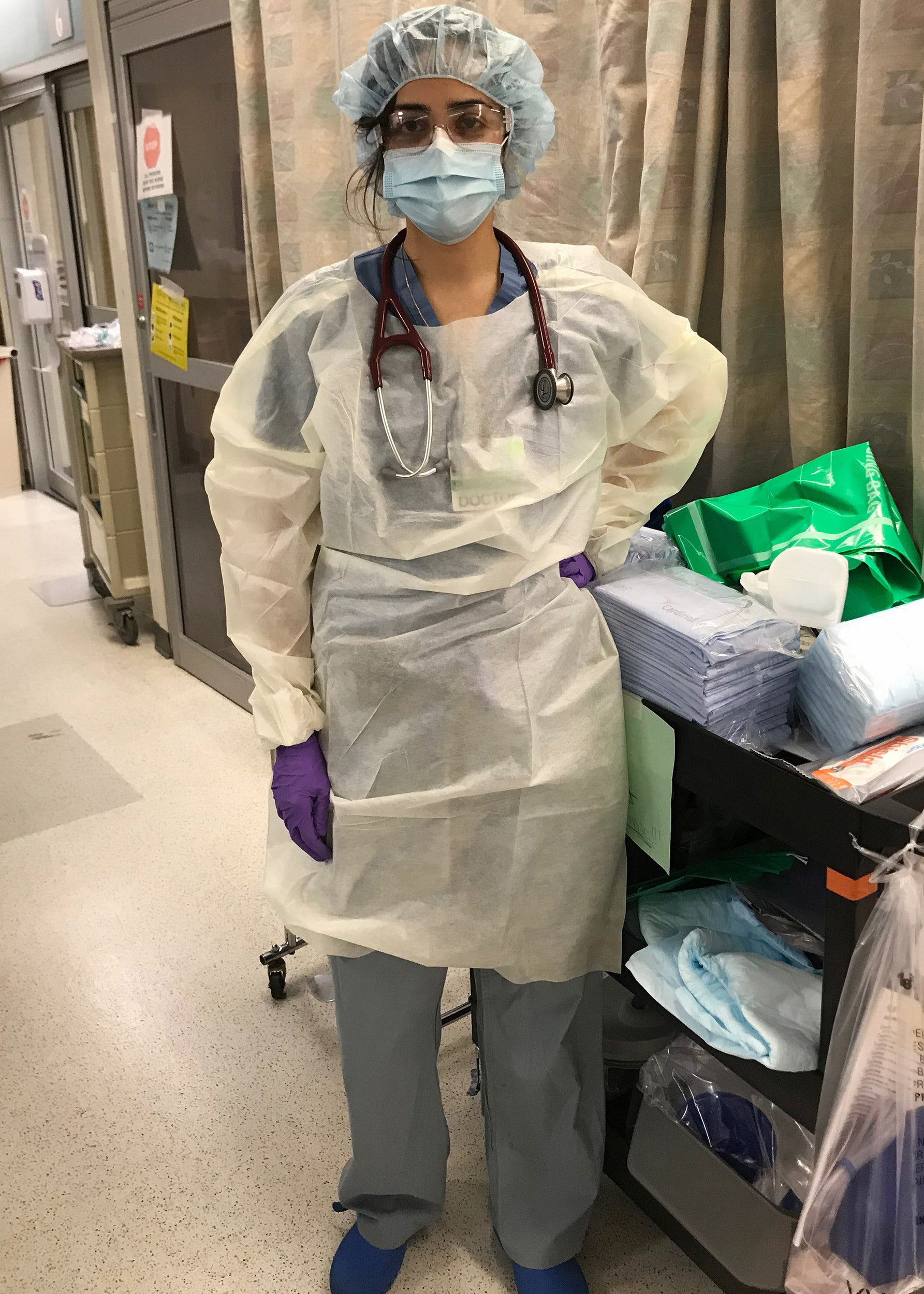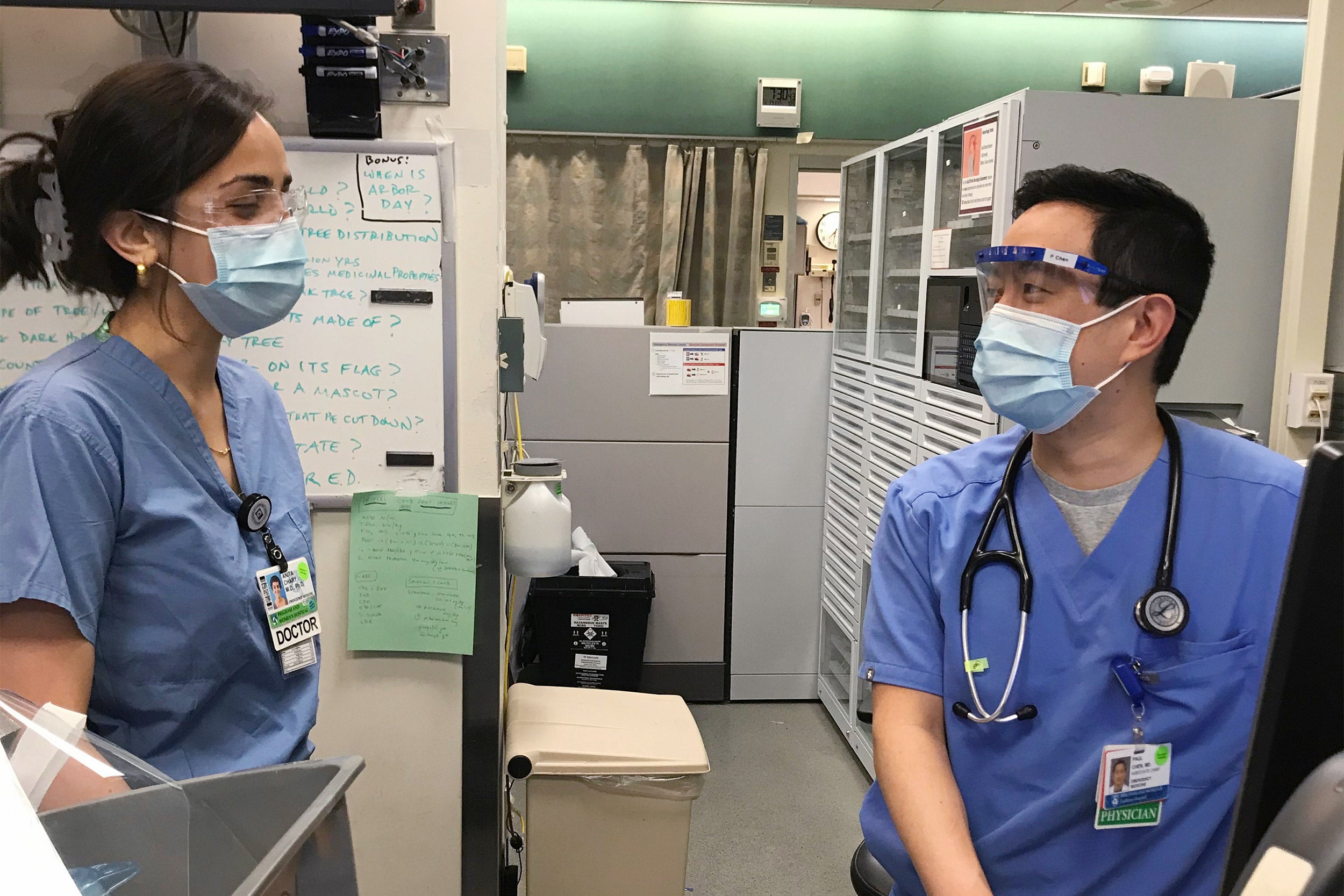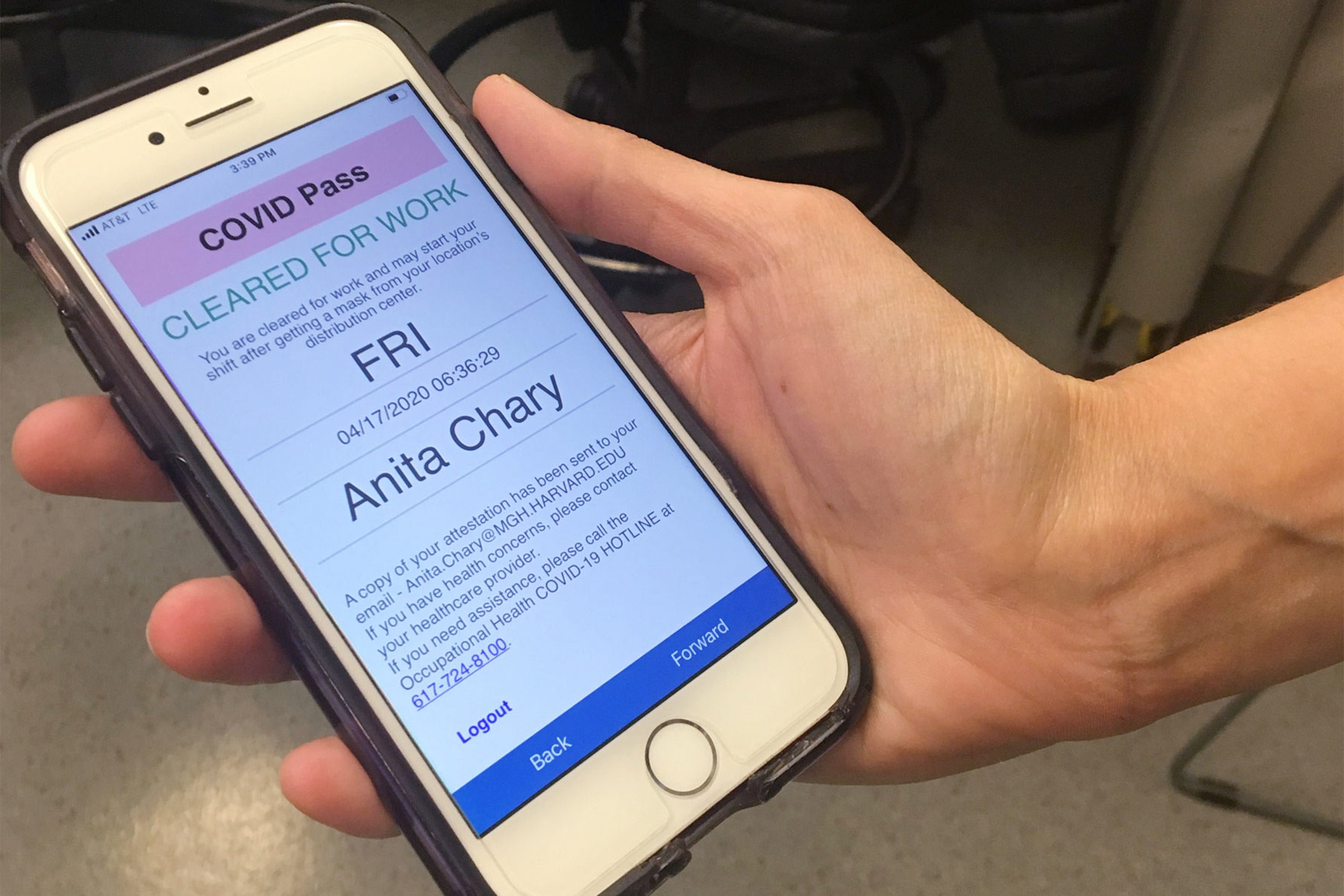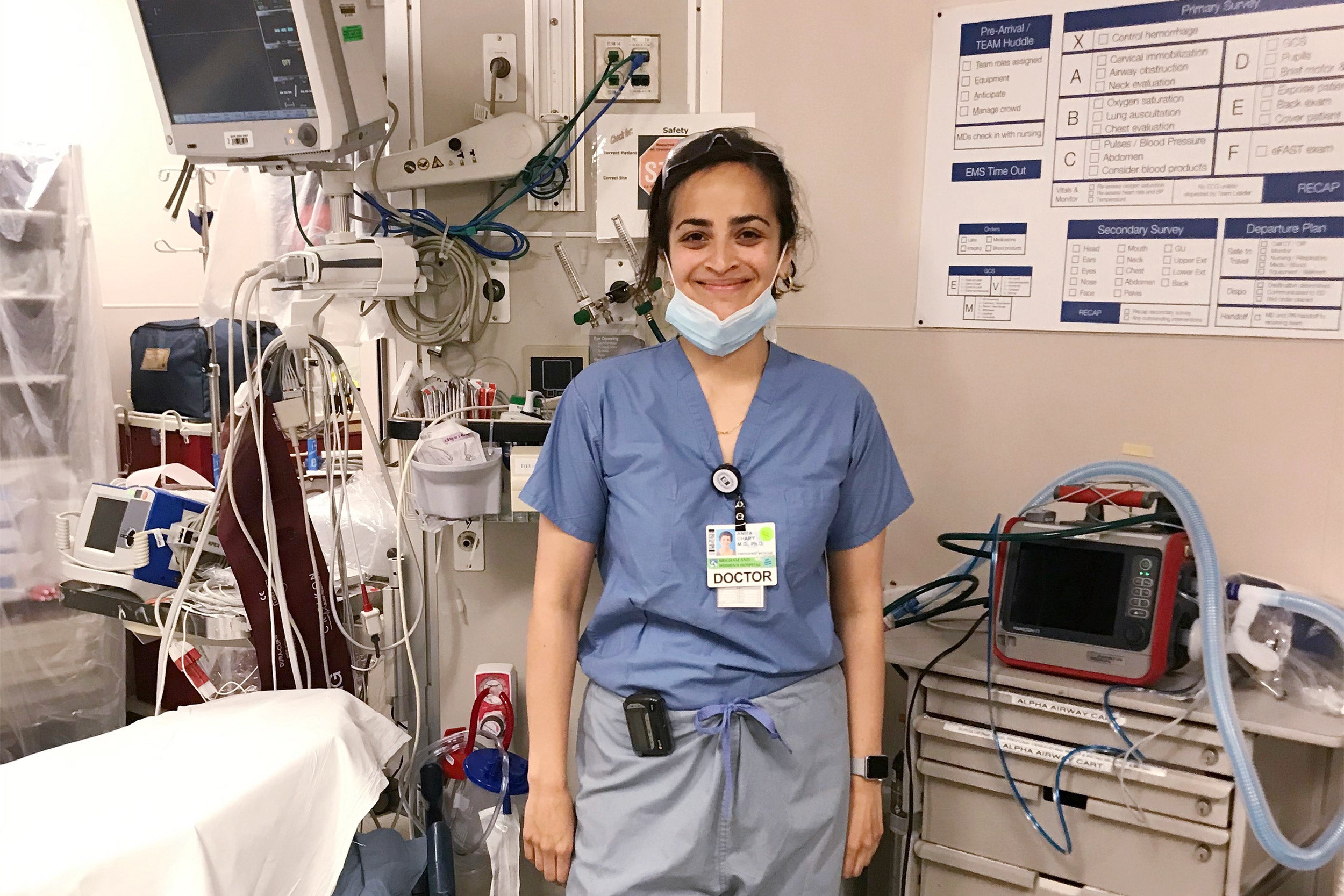A day in the life of an ER doc Third-year resident Anita Chary describes the personal and professional trials brought by the pandemic ......... She is given a mask to wear, then winds her way through tunnels to her department, where she dons blue scrubs, face shield, and goggles and begins another nine-hour shift in an emergency room, the front line of the nation’s worst public health crisis in more than a century. ........... divides patients suffering with symptoms of the virus, or with a positive diagnosis, into three categories:
those who are well enough to leave and recover at home; those who must be admitted because they need oxygen to help them breathe; and those who need intensive care and a ventilator
. .......... many who arrive at the ER not sick enough to be hospitalized. Chary watches them leave tortured by the thought of infecting loved ones. “It’s the prospect of going home and potentially spreading coronavirus to other people at home that is just so difficult for them to bear.” ......... Her sleep has suffered, she says, the result of an overwhelming need to check her patients’ electronic charts for updates. “I try to do it before I go to bed at night; it’s the first thing I do in the morning. It’s just this higher level of constant concern about the patients that I’ve had.” .......... “With younger patients it can be particularly devastating when you see they are still not doing better after being in the ICU for weeks.” .......... the influx of lower-income patients from communities of color. ......... “I often find that these patients are working in essential jobs,” she says. “They are working in grocery stores; they are operating public transport; they’re in custodial services; or they’re doing things like home delivery. And sothey’re really on the front lines of society just as much as we are in the hospital
. Working from home is not an option. And it’s also difficult for them to do social distancing and isolate because they live in smaller apartments, and they tend to live in multigenerational households where people are sick, too.” ............ Chary knows death comes with being a doctor specializing in urgent care, but some of the unique aspects of this disease can still shake her. Many physicians have noted how quickly conditions can deteriorate and the high death rates for those placed on ventilators. .......... At the urging of the hospital’s palliative-care team, Chary and her colleagues are having patients requiring a ventilator record messages to loved ones on their phones before they are sedated. “That has been one of the most powerful experiences,” says Chary, her voice shaking. “Handing someone their phone and listening to them tell their family they love them and just hoping that they will be able to speak to their loved ones again after they come off the ventilator, but not knowing.” ..........She’s heard horror stories from friends and colleagues in places like New York City and Detroit, where refrigerated trucks idle outside hospitals storing the bodies of those who have passed away, while inside patients overwhelm sickbays, sometimes dying before a doctor can get to them.
............ limiting her and her colleagues’ exposure to the virus is a constant concern ........ more than 9,000 health professionals had been infected by the coronavirus, including more than 320 at the Brigham. ........ When her shift ends at 4 p.m. Chary prepares to head out, disinfecting her phone and stethoscope with sanitizer, meticulously washing her hands and arms up to her elbows, and changing out of her blue scrubs into clean clothes. Back in her apartment she showers as soon as she walks in, a normal part of her daily routine in the age of coronavirus. ....... Chary unwinds with Netflix and calls to family. Her parents in Illinois are in the high-risk category, over the age of 65 with underlying health conditions, and, as with her husband, she hasn’t seen them for months. “It’s hard, but the safest thing for myself, my loved ones, and society is to not travel right now,” Chary says. ..........‘Hands that serve are holier than lips that pray.’
COVID-19’s Hard Lessons Might Prepare Business for Climate Change the catastrophe might force companies to face a crisis that has been unfolding in plain sight: climate change. ...... In the short run, COVID-19 changes everything, just because nearly every company is so stressed. In the long run, I hope that companies will emerge from the crisis with a renewed appreciation for the importance of paying attention to the potential for catastrophic risks such as climate change, and for the importance of building government capacity equipped to deal with major public crises. .........
COVID-19 is making climate increasingly a top-of-mind issue.
But keep pinching those federal pennies when it comes to New York’s teachers, hospitals, and first responders.
— James Skoufis (@JamesSkoufis) May 11, 2020
This is the definition of un-American. https://t.co/NHwCaAow97
Economic earthquake: Consumer spending in the wake of the coronavirus pandemic consumer spending in the U.S. fell off a cliff in March. That’s when bars, concert halls, movie theaters and other nonessential businesses across much of the country shuttered to try to stem the spread of the new coronavirus. ......... places that account for a large share of GDP, like Los Angeles and New York counties, having almost completely shut down. ........ the biggest chunk — about 70% of GDP — comes from money Americans spend domestically. .......... The current situation more closely resembles a natural disaster than a traditional recession, according to economists at the Federal Reserve Bank of New York. The supply of things to spend money on has been stanched. It’s like
a national-level Hurricane Katrina
, the storm that devastated New Orleans in August 2005 ......... The coronavirus pandemic has caused an economic shock — not unlike an earthquake. ........ The big one — the 1929 stock market crash and depression that followed — was a magnitude 10 .......... The 1987 stock market crash was a magnitude 7, and the 2008 housing bubble was a magnitude 8.5. ........ puts the coronavirus recession ata magnitude 9
, with the caveat that “many unknowns remain.” ........ Shutting down the U.S. economy is an extreme step, but the stakes are life or death. ........ half a million lives could be saved as a result of social distancing measures that drastically reduce consumer spending ...........“Abandoning containment policies prematurely leads to an initial economic recovery ......... But it also leads to a large rise in infection rates. That rise causes a new, persistent recession.”
......... real GDP would plummet 15% in the first quarter. ......... GDP could shrink by 10% in the second quarter of 2020 compared with the first quarter, and the unemployment rate could reach 15% by midyear ..........annualized GDP would fall 34% in the second quarter.
..........unemployment rate would be in the 26% to 51% range
if Goldman’s GDP estimates are on target. Goldman expects a partial rebound in the last two quarters of the year. ......... “When people hear the economy is going to shrink by a third, they think that’s maybe a little bit implausible,” Goldman chief economist Jan Hatzius said in a podcast from early April. “But that’s not what we’re saying. We’re saying that the economy basically shrinks by 10% relative to the first quarter, or April shrinks by 13% relative to January.” ........... By the end of 2020, Goldman estimates GDP will contract about 6% compared with 2019. ......... advanced economies, like the U.S., Canada, Japan and the United Kingdom, will contract on average about 6% in 2020 due to“the Great Lockdown”
........... Unemployment benefits will extend through the end of the year, longer than the typical benefit period of about six months. ......... “It’s much more important to give households money for a longer period of time than more money up front” ........And if the economy reopens too soon, a deeper recession could follow.
The Federal Reserve must reduce long-term damage from coronavirus Reviving crisis-era programmes is a first step but the central bank may need to buy corporate bonds ........ Fiscal policy will certainly have to do more as the size of the hit to economic activity becomes apparent. ......... Some of the actions recently announced by the Fed, including cutting the short-term policy rate nearly to zero and preparing to buy at least $700bn in Treasury debt and mortgage-backed securities, are superficially similar to those taken by monetary policymakers during the 2008 financial crisis. ......... the problem is not originating from financial markets: they are only reflecting underlying concerns about the potential damage caused by the coronavirus pandemic, which of course monetary policy cannot influence. ....... stabilising financial markets, which have been highly volatile and have not functioned normally. Communications difficulties among teleworking or siloed traders and selling from leveraged traders who are having to post additional cash to meet margin calls as share prices fall may have contributed to the market’s illiquidity. The most important financial markets, including those for US Treasury debt and mortgage-backed securities, must work properly if lenders are to feel confident about extending credit to households and businesses in such unusual times..............
Ideally, when the effects of the virus pass, people will go back to work, to school, to the shops, and the economy will return to normal. In that scenario, the recession may be deep, but at least it will have been short.
............ But that isn’t the only possible scenario:if critical economic relationships are disrupted by months of low activity, the economy may take a very long time to recover. Otherwise healthy businesses might have to shut down due to several months of low revenues. Once they have declared bankruptcy, re-establishing credit and returning to normal operations may not be easy. If a financially strapped firm lays off — or declines to hire — workers, it will lose the experienced employees needed to resume normal business. Or a family temporarily without income might default on its mortgage, losing its home
. ................... To avoid permanent damage from the virus-induced downturn, it is important to ensure that credit is available for otherwise sound borrowers who face a temporary period of low income or revenues. One of the Fed’s principal goals is to ensure that credit is available. ......... Central bank tools cannot eliminate the direct costs of the virus, including the suffering and loss it will create. However, the Fed can help mitigate the economic effects of the outbreak, particularly by assuring that, once the virus’s direct effects are controlled, the economy can rebound quickly.Russia: Pandemic tests Putin’s grip on power Moscow has been criticised for failing to act quickly enough in a crisis that is sapping its oil-dependent economy .......... In addition to a six-week national lockdown and crippling quarantine measures that have suffocated domestic industry, the pandemic has contributed to a more than halving of the price of oil, imperilling the country’s financial lifeblood. ........ Profits from oil and gas sales provide around 50 per cent of Russia’s consolidated budget revenue — about $130bn. Since oil prices plunged, partly due to Mr Putin’s ill-fated decision to embark on a price war with Saudi Arabia to hurt US shale producers, a $165bn war chest built up to protect the economy is being drained by as much as $300m a day .......... Mr Putin faces a multi-faceted crisis that has shaken his authority and the informal social contract that underpins his rule: to provide security and economic stability to voters in exchange for restrictions on their political freedoms. ............ Mr Putin’s approval rating has fallen to a six-year low. One measure of public trust in him is at 28 per cent — the lowest since 2006 — just 18 months before Russia’s parliamentary elections............ Protests have also taken place online, with citizens posting thousands of anti-Putin comments at government locations on the Yandex.Maps mobile navigation app....... Mr Putin’s approval rating fell to 63 per cent in March, down from 69 per cent in February. While exceptionally high for a European politician, Mr Putin has almost no political opponents, and it is well below the ratings in the high-80s he enjoyed between 2014 and 2018. The state-run VTsIOM found in a recent survey that just 28 per cent of respondents named Mr Putin when asked which politicians they trusted. .............






No comments:
Post a Comment